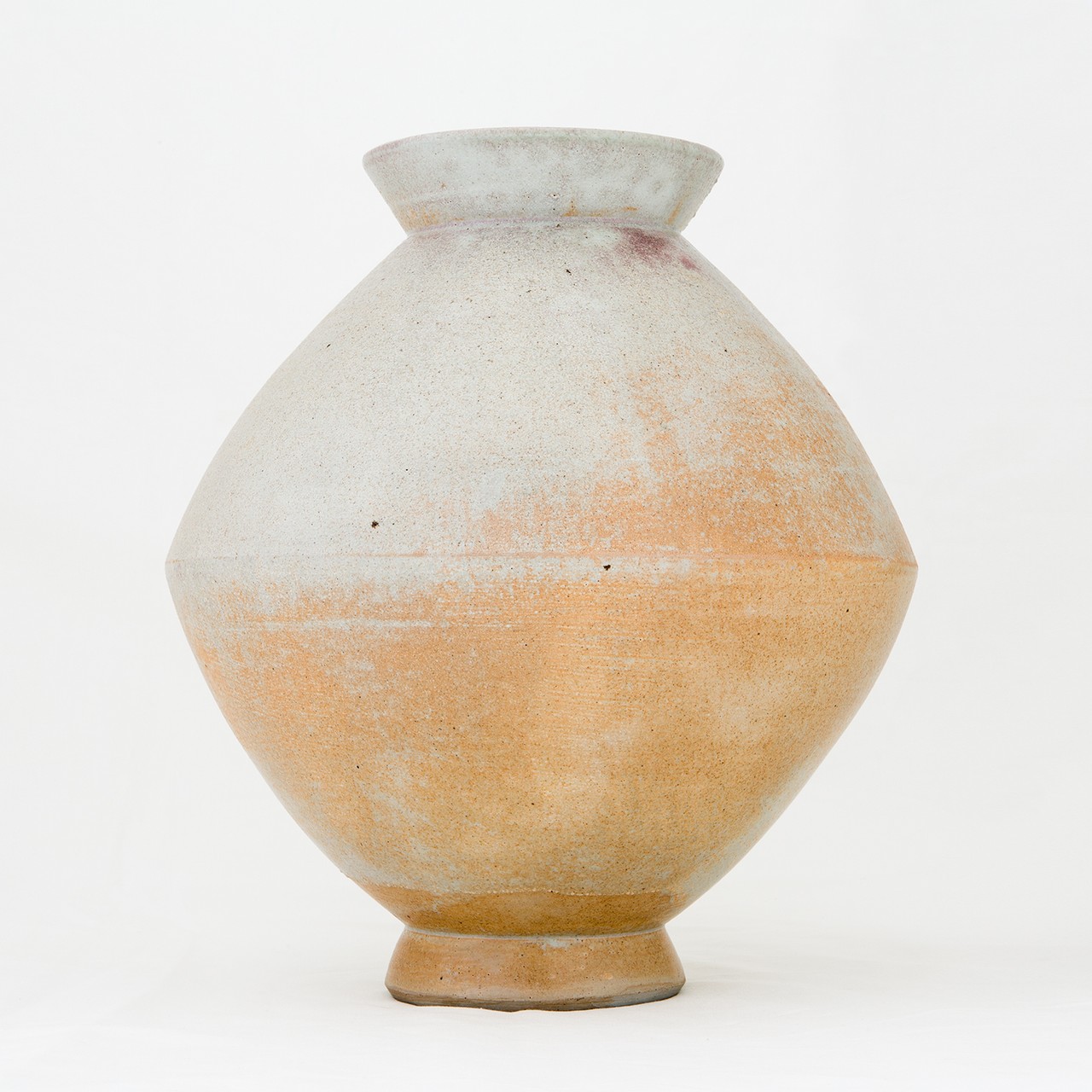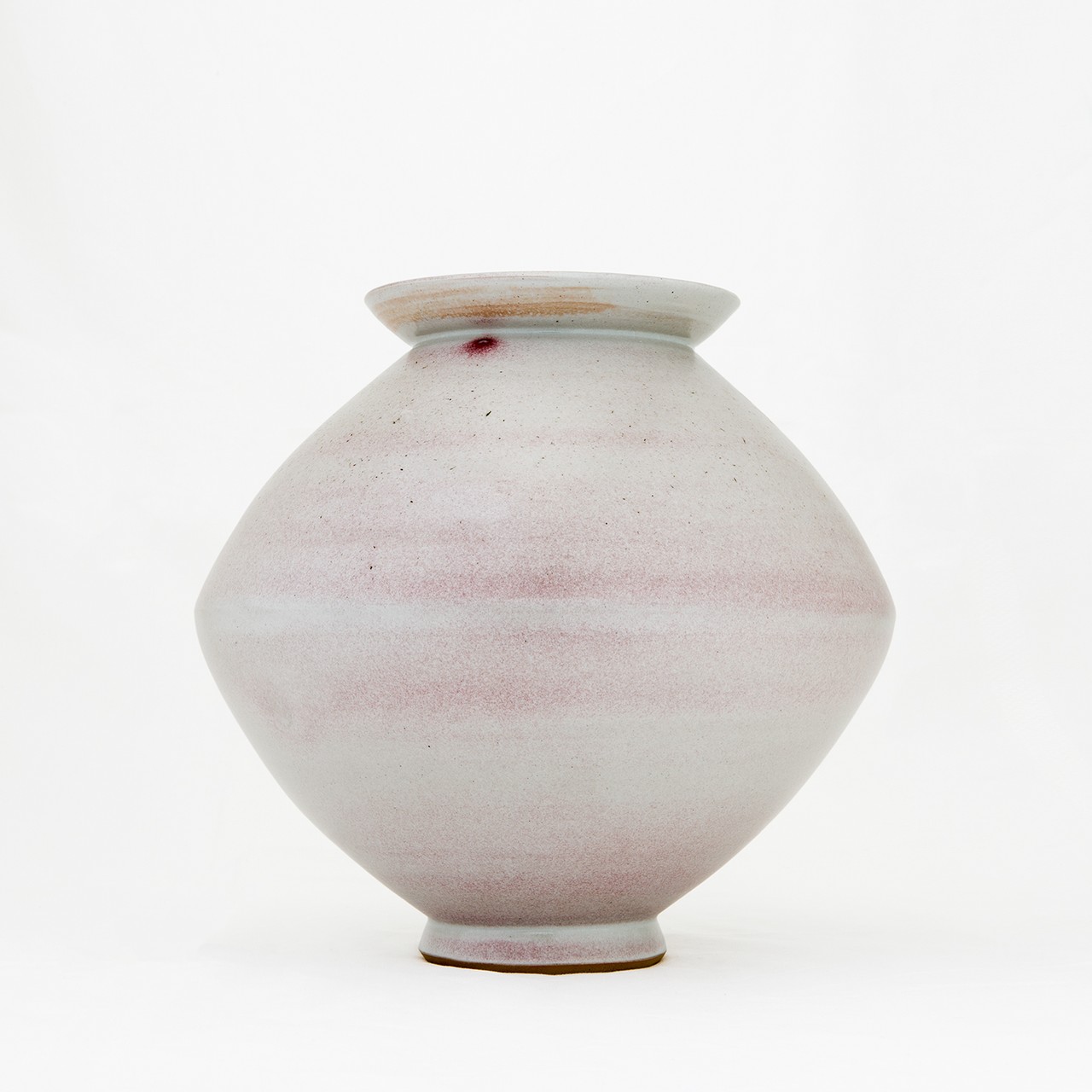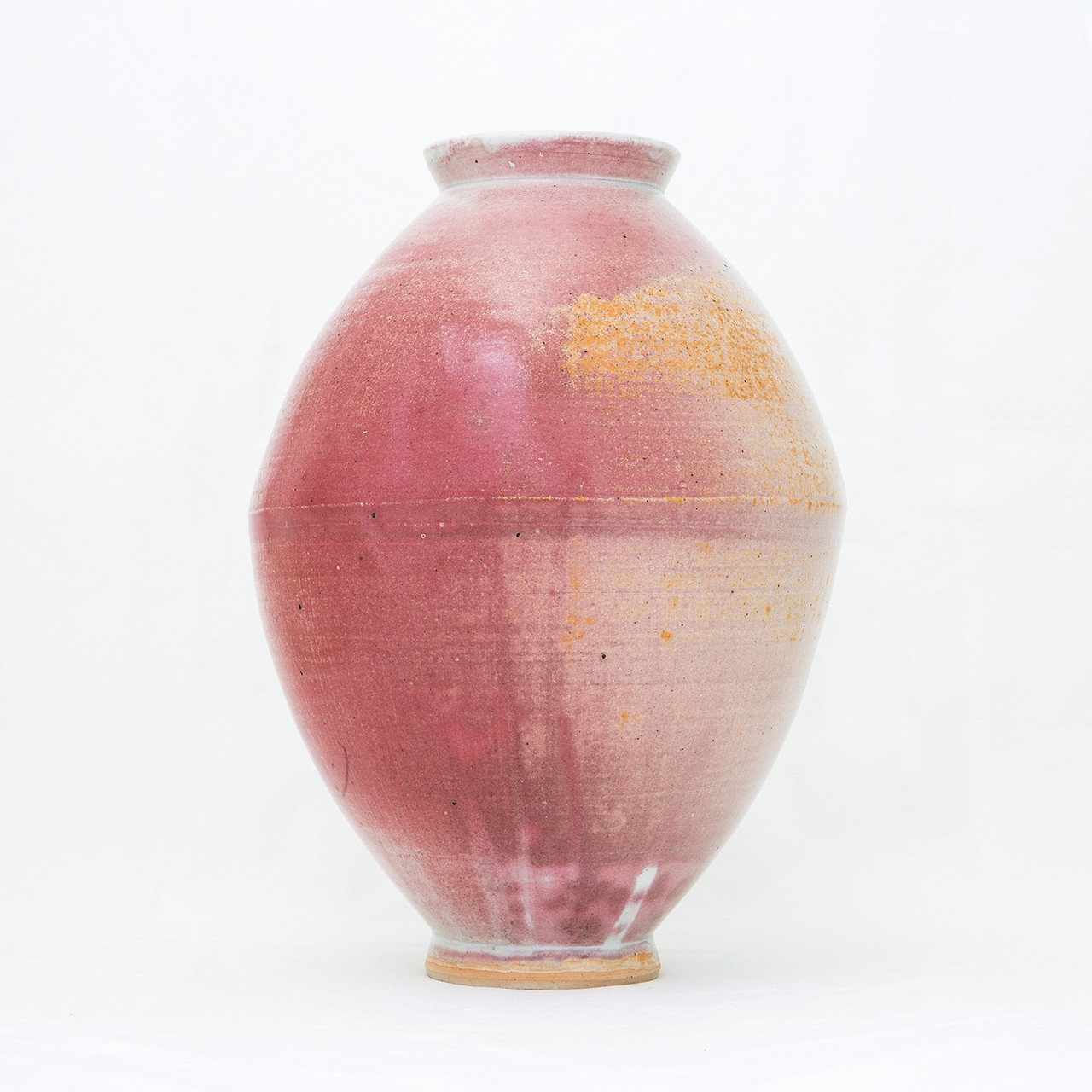Young-Jae Lee
Ceramic Works
13 Jan - 24 Feb 2018

Young-Jae Lee, Untitled (4), 2004, Ceramics, spindle vase, Height: 41 cm, Ø 28 cm; Photo: Il Suuk Lee

Young-Jae Lee, Untitled (15), 2005, Ceramics, spindle vase, Height: 33,5 cm, Ø 31 cm; Photo: Il Suuk Lee

Young-Jae Lee, Untitled (36), 1997, Ceramics, spindle vase, Height: 42 cm, Ø 25,5 cm; Photo: Il Suuk Lee

Young-Jae Lee, Untitled (41), 2004, Ceramics, spindle vase, Height: 37,5 cm, Ø 28 cm; Photo: Il Suuk Lee
Galerie Karsten Greve is exhibiting for the first time ceramic works by the Korean artist Young-Jae Lee. Born in Seoul in 1951, she studied at the College of Art Education in her native city before moving to Germany in 1972. After studying ceramics and design at Wiesbaden Polytechnic from 1973 to 1978, she ran her own workshop in Sandhausen near Heidelberg. Since 1987 Lee has been running the long-established Ceramics Workshop Margaretenhöhe in Essen.
The artistic work of Young-Jae Lee displays cross-cultural influences and sculptural considerations and has met with great acclaim, not least as a result of room-filling museum presentations. Starting out from the simple basic form of a bowl, a vase or a beaker, which spreads out across the floor in countless variations, in 2006 for example she distributed 1,111 bowls in the rotunda of the Pinakothek der Moderne in Munich. She repeated this mise-en-scène of ‘uniqueness within the series’ in 2008 with a display of spindle vases in the same location.
The presentation in the Galerie Karsten Greve focuses on these spindle vases. This form of design is based on the hang-a-ri, a Korean storage vessel, whose round form is dictated by the abundance of its intended content. Developed from practical use, the mouth was made larger than the foot to allow stacking (the foot fits into the mouth of the jar below). The typical form is a smooth sphere, but Lee’s version consists of two separately thrown bowls, almost mirror images of each other, which are then put together so that their rims meet, forming a visible join, comparable to the putting together of open hands. As a result of the shallow foot ring, the eye is drawn to the spreading form, whose curved walls culminate in a circumferential ridge, which, as a strikingly edgy contour becomes the unmistakable hallmark of this group of works. This interpenetration of single and double forms is also reflected in the current installation. Alongside the spindle vases placed on plinths, numerous bowls (as ‘halves’ of spindle vases) are spread all over the floor. In their delicate nuances, the white opens up into a whole spectrum of colour, while the dynamic formations create a positively cosmological panorama, a poetic reflexion on origin and creation.
From the sixteenth century and the Japanese occupation that began around that time, the traditional hang-a-ri came to be distinguished by a white glaze resulting from a shortage of coloured pigments. White, the absence of colour, became the symbol of mourning for the loss of Korean identity, a significance which was veiled by the use of the term ‘moon pot’ in collector circles in the 1920s and 30s. It was above all the white of these traditional vases and its roots in Korean history that led Young-Jae Lee to ceramics in the first place: ‘Quite generally, the white of the hempen fibres, the white of the rice paper, the white of thin and thick linen, of silk which no bleach makes whiter’ (Young-Jae Lee). After moving to Germany, her predilection for white was echoed in Chardin’s painted faience jars and jugs, the ‘Girl in a White Dress’ by Renoir, and above all in the works of Piero Manzoni.
Although Young-Jae Lee takes up the white of Korean pottery, she does not retain the pristine form of her predecessors. Pursuing a minimalist view of form, Lee combines, in the harmonious union of bowls, both historic and contemporary design principles. She describes her use of traditional forms as ‘re-definition’. She is not concerned with formal invention, nor with originality, but with the individuality of the vessel, the singularity of the resulting sculptural form. As a result of the firing in a wood-fired kiln, individual flakes of ash land on the pale glaze, giving rise to dark speckles and uneven patches in the surface. Such blemishes stand for chance, unpredictability, and ultimately for the uniqueness of the object. A further input into the production is the essence of the potter, her immediate physical and emotional composure, so that alongside decisions taken with deliberation, the process is also determined by spontaneous impulses and stimuli.
Lee’s work principle and artistic self-conception is defined by the assumption that the modification of a basic form produces a multiplicity of variations in design – uniqueness in repetition. Heavily influenced by her studies in Wiesbaden, her activity focuses not on fey meditative practice, but on the concrete and concentrated sculptural attention to a material, the ‘hand-work’. The modelling of a simple geometric form from the clay is done with a pronounced awareness of proportions derived from the human figure. Lee understands this process, from which her works emerge as ‘abstractions of the human body’, as the ‘taming’ of the ductile, elastic mass as it is acted upon by centrifugal force.
This design, conditioned by ‘purpose’, ‘material’ and ‘construction’ in the spirit of ‘form follows function’ is in the tradition of the Deutscher Werkbund and the Bauhaus. The Folkwang concept of Karl-Ernst Osthaus, the original begetter of the Keramische Werkstatt Margaretenhöhe, also informs Lee’s holistic approach, which renders otiose the distinction between arts and crafts. Permeated by her universal concept of art, which transcends cultures and takes sustenance also from music, literature and theatre, Young-Jae Lee’s artist works, as timeless models between tradition and innovation, unfold an individual, unmistakable aura beyond any fashions and mannerisms.
The artistic work of Young-Jae Lee displays cross-cultural influences and sculptural considerations and has met with great acclaim, not least as a result of room-filling museum presentations. Starting out from the simple basic form of a bowl, a vase or a beaker, which spreads out across the floor in countless variations, in 2006 for example she distributed 1,111 bowls in the rotunda of the Pinakothek der Moderne in Munich. She repeated this mise-en-scène of ‘uniqueness within the series’ in 2008 with a display of spindle vases in the same location.
The presentation in the Galerie Karsten Greve focuses on these spindle vases. This form of design is based on the hang-a-ri, a Korean storage vessel, whose round form is dictated by the abundance of its intended content. Developed from practical use, the mouth was made larger than the foot to allow stacking (the foot fits into the mouth of the jar below). The typical form is a smooth sphere, but Lee’s version consists of two separately thrown bowls, almost mirror images of each other, which are then put together so that their rims meet, forming a visible join, comparable to the putting together of open hands. As a result of the shallow foot ring, the eye is drawn to the spreading form, whose curved walls culminate in a circumferential ridge, which, as a strikingly edgy contour becomes the unmistakable hallmark of this group of works. This interpenetration of single and double forms is also reflected in the current installation. Alongside the spindle vases placed on plinths, numerous bowls (as ‘halves’ of spindle vases) are spread all over the floor. In their delicate nuances, the white opens up into a whole spectrum of colour, while the dynamic formations create a positively cosmological panorama, a poetic reflexion on origin and creation.
From the sixteenth century and the Japanese occupation that began around that time, the traditional hang-a-ri came to be distinguished by a white glaze resulting from a shortage of coloured pigments. White, the absence of colour, became the symbol of mourning for the loss of Korean identity, a significance which was veiled by the use of the term ‘moon pot’ in collector circles in the 1920s and 30s. It was above all the white of these traditional vases and its roots in Korean history that led Young-Jae Lee to ceramics in the first place: ‘Quite generally, the white of the hempen fibres, the white of the rice paper, the white of thin and thick linen, of silk which no bleach makes whiter’ (Young-Jae Lee). After moving to Germany, her predilection for white was echoed in Chardin’s painted faience jars and jugs, the ‘Girl in a White Dress’ by Renoir, and above all in the works of Piero Manzoni.
Although Young-Jae Lee takes up the white of Korean pottery, she does not retain the pristine form of her predecessors. Pursuing a minimalist view of form, Lee combines, in the harmonious union of bowls, both historic and contemporary design principles. She describes her use of traditional forms as ‘re-definition’. She is not concerned with formal invention, nor with originality, but with the individuality of the vessel, the singularity of the resulting sculptural form. As a result of the firing in a wood-fired kiln, individual flakes of ash land on the pale glaze, giving rise to dark speckles and uneven patches in the surface. Such blemishes stand for chance, unpredictability, and ultimately for the uniqueness of the object. A further input into the production is the essence of the potter, her immediate physical and emotional composure, so that alongside decisions taken with deliberation, the process is also determined by spontaneous impulses and stimuli.
Lee’s work principle and artistic self-conception is defined by the assumption that the modification of a basic form produces a multiplicity of variations in design – uniqueness in repetition. Heavily influenced by her studies in Wiesbaden, her activity focuses not on fey meditative practice, but on the concrete and concentrated sculptural attention to a material, the ‘hand-work’. The modelling of a simple geometric form from the clay is done with a pronounced awareness of proportions derived from the human figure. Lee understands this process, from which her works emerge as ‘abstractions of the human body’, as the ‘taming’ of the ductile, elastic mass as it is acted upon by centrifugal force.
This design, conditioned by ‘purpose’, ‘material’ and ‘construction’ in the spirit of ‘form follows function’ is in the tradition of the Deutscher Werkbund and the Bauhaus. The Folkwang concept of Karl-Ernst Osthaus, the original begetter of the Keramische Werkstatt Margaretenhöhe, also informs Lee’s holistic approach, which renders otiose the distinction between arts and crafts. Permeated by her universal concept of art, which transcends cultures and takes sustenance also from music, literature and theatre, Young-Jae Lee’s artist works, as timeless models between tradition and innovation, unfold an individual, unmistakable aura beyond any fashions and mannerisms.
